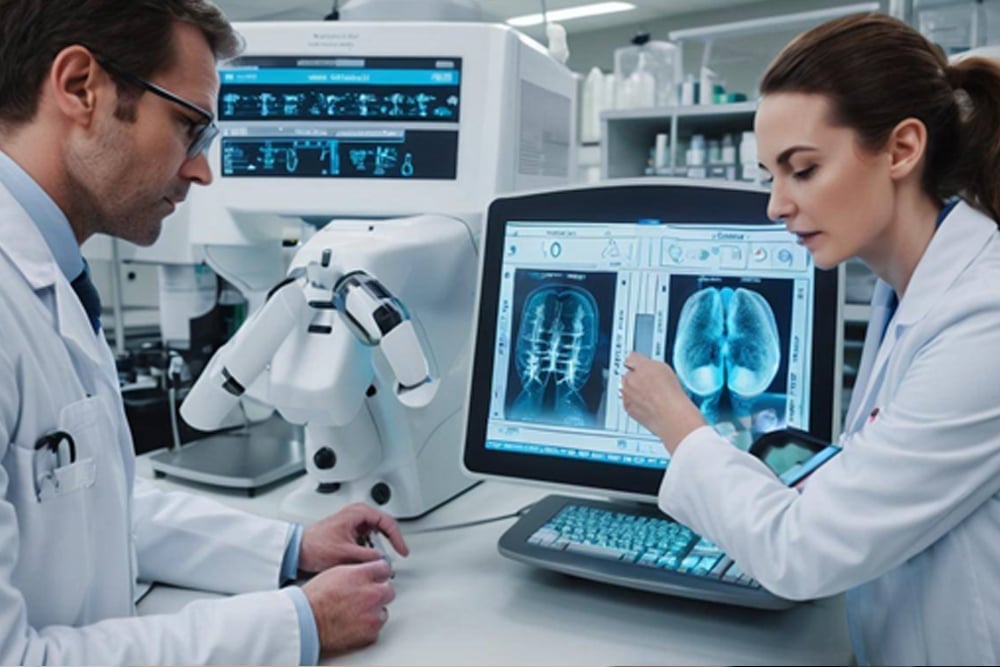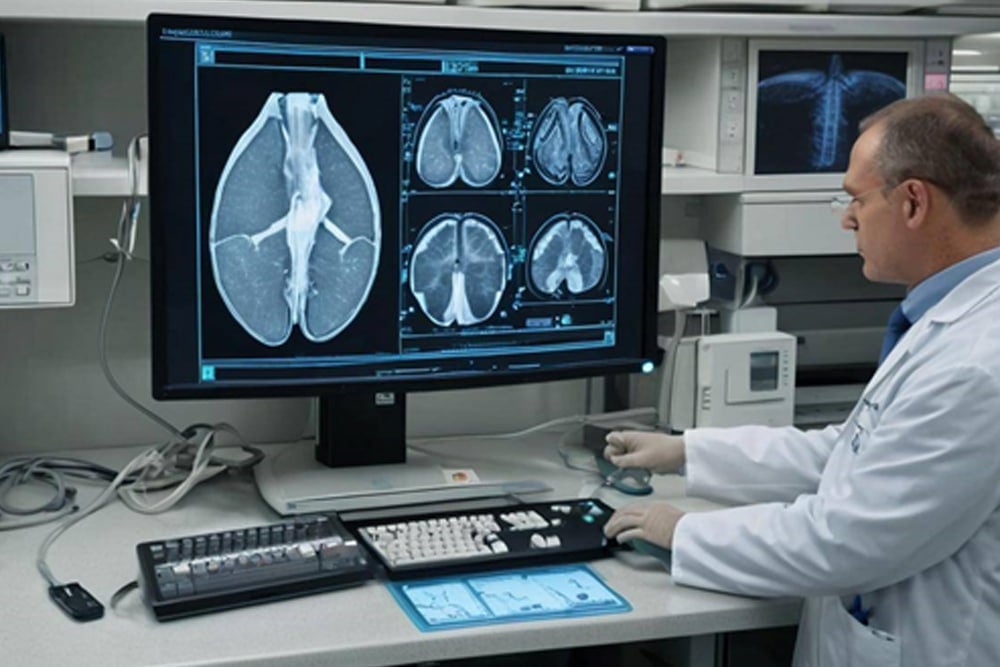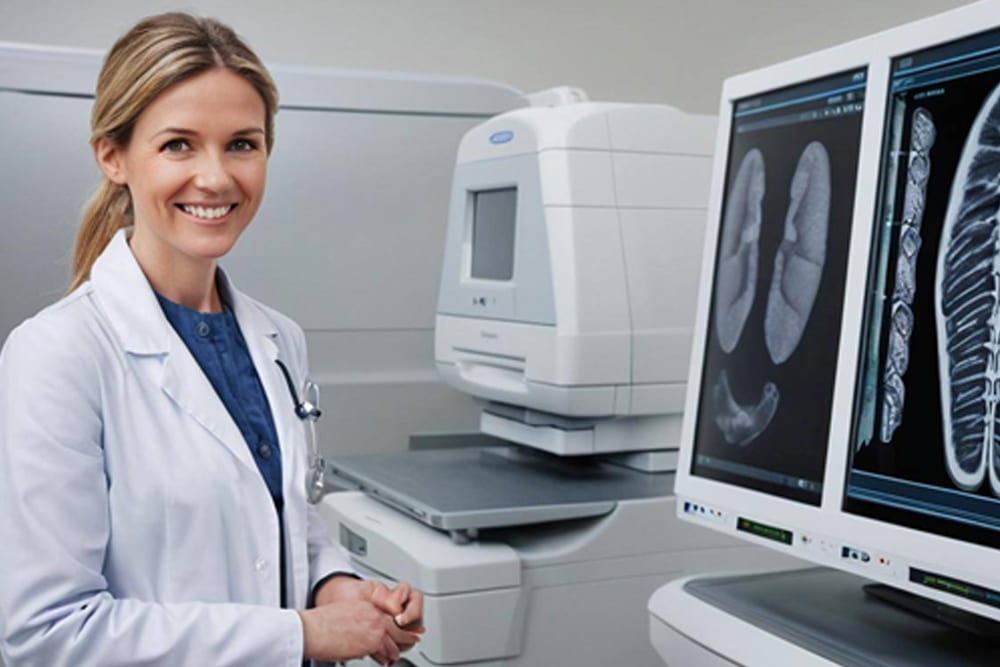Advances in Diagnostic Technology: Reducing Cancer Misdiagnosis for Better Healthcare
The world of medicine is witnessing a game changer - the advent of advanced diagnostic technology capable of providing early and accurate cancer detection. This could be the cornerstone of reforming patient care as it increases efficiency and accuracy in diagnosis, substantially diminishing cancer misdiagnosis incidents. Imagine having this comfort; not just believing but knowing your health situation has been accurately assessed, down to minute details that were previously invisible. Now, instead of grappling with uncertainty, patients can confidently embark on their treatment journey. Let's explore how this change has come about.
Advanced diagnostic technologies, such as AI-assisted imaging and computer-aided detection systems, play a crucial role in reducing cancer misdiagnosis by providing highly accurate diagnostic reports and serving as a "second opinion" for radiologists. These technologies quantify imaging data, use deep learning for automated recognition of features from medical images, and enable automated segmentation and characterisation of tumours with increased accuracy, thereby enhancing the precision of cancer diagnosis.

State of Cancer Diagnostic Technology
The landscape of cancer diagnostic technology has undergone a remarkable transformation in recent years. Advancements have steered the field toward more accurate, efficient, and less invasive diagnostic tools. These breakthroughs are not only crucial in the early detection of cancer but also play a pivotal role in guiding appropriate treatment pathways for patients.
Take, for instance, molecular diagnostic techniques, which have emerged as a game-changer in cancer diagnostics. These techniques enable healthcare professionals to analyse genetic alterations and molecular markers in tissue samples. By understanding the specific genetic makeup of a tumour, doctors can prescribe targeted therapies that are tailored to the individual patient's tumour. This personalised approach to treatment has significantly improved patient outcomes and reduced the risk of misdiagnosis by ensuring that therapies are better aligned with the unique characteristics of each patient's cancer.
Furthermore, advancements in imaging modalities such as positron emission tomography (PET), magnetic resonance imaging (MRI), and computed tomography (CT) have revolutionised the screening, staging, and monitoring of tumours. These sophisticated imaging techniques provide clinicians with detailed insights into tumour characteristics, aiding in precise diagnosis and treatment planning.
The integration of artificial intelligence (AI) algorithms in cancer diagnostics has also been a game-changer. AI-driven platforms can process vast amounts of data from imaging studies and pathology reports to identify patterns and anomalies that may not be readily discernible by human observers. This not only enhances the accuracy of diagnostic interpretations but also expedites the analysis of complex medical data, leading to faster and more informed decision-making.
In addition, the development of next-generation sequencing technologies has empowered healthcare providers to decipher the genetic makeup of tumours with unprecedented speed and precision. By unravelling intricate genomic profiles, clinicians can gain valuable insights into the mechanisms underlying cancer progression and identify potential therapeutic targets that were previously undetectable through conventional methods.
The state of cancer diagnostic technology continues to evolve, ushering in a new era of precision medicine that holds tremendous promise for improving patient care, mitigating misdiagnosis risks, and ultimately advancing the fight against cancer.
As technological innovation continues to redefine the landscape of cancer diagnosis, let's now delve deeper into the groundbreaking advancements fuelling early detection and imaging technology.
Breakthroughs in Early Detection and Imaging Technology
Are you ready? There's a lot to cover when it comes to the powerful technological advancements that have greatly enhanced our ability to detect cancer early. Let's begin by examining high-resolution imaging.
High-Resolution Imaging
Technology has come a long way, and it shows in the level of detail we can now capture with high-resolution imaging techniques like MRI (magnetic resonance imaging), CT scans (computed tomography), and PET scans (positron emission tomography). These technologies provide incredibly precise images of tumours and cancerous cells, allowing doctors to detect cancer at its earliest stages.
High-resolution imaging is about more than just clear pictures; these techniques play a critical role in precisely localising abnormal growths within the body. Doctors can pinpoint the exact location of cancerous growths, making treatment planning more effective and reducing any unnecessary damage to healthy tissues.
But wait! Another exciting advancement in cancer diagnostics is the concept of liquid biopsies.
Liquid Biopsies
Imagine being able to analyse blood samples for circulating tumour cells, DNA, and RNA shed by tumours - all without invasive methods. That's the groundbreaking potential of liquid biopsies. By examining these components in the bloodstream, medical professionals can monitor for the existence of cancer cells or genetic material associated with cancer. This non-invasive approach allows for early detection of cancer and continuous monitoring of treatment progress, offering a level of insight that was previously unavailable without invasive procedures.
This mode of diagnosis opens up new possibilities for timely intervention and personalised treatment plans tailored to each patient's unique genetic makeup. It's truly a game-changer in the fight against cancer.
Now, let's touch on another significant advancement: genetic profiling.
Genetic Profiling
The progress made in genetic testing technology has given us the ability to delve deep into the genetic mutations and biomarkers associated with different types of cancer. Through genetic profiling, healthcare providers can identify specific genetic characteristics unique to an individual's cancer, providing insights that guide personalised treatment approaches. This kind of tailored approach is transforming the way we tackle cancer, allowing for precision medicine that targets the specific genetic factors driving cancer growth.
Understanding the genetic underpinnings of cancers enables doctors to make informed decisions about which treatments are likely to be most effective for each patient. This personalization marks a significant shift away from traditional one-size-fits-all approaches, ushering in an era of customised care that holds promise for improving patient outcomes across various types of cancer.
With these tremendous steps forward in technological innovation, we're witnessing a paradigm shift in how we approach cancer diagnostics and treatment. It's an exhilarating time as we witness these breakthroughs carving pathways towards more accurate diagnoses and tailored treatment plans that bring hope and healing to those affected by this challenging disease.
As we marvel at these remarkable advancements in diagnostic technology, the next section will shine a spotlight on the pivotal role of radiation detection in revolutionising cancer diagnosis.
Gathering Evidence for Your Claim
Radiation detection technology has significantly advanced the capabilities of medical professionals in diagnosing and treating cancer. One of the most crucial applications of this technology is in digital mammography, a specialised type of X-ray imaging used to detect breast cancer. Digital mammography provides highly detailed and accurate images of the breast tissue, allowing radiologists to identify abnormalities such as tumours or calcifications.
Furthermore, positron emission tomography (PET) is another invaluable tool powered by advanced radiation detection systems. PET scans are adept at producing detailed images of the body's internal functions at a molecular level, offering unparalleled insights into abnormal tissue growth and metabolic activity. These intricate images assist medical practitioners in detecting metastases, accurately staging cancers, and devising highly individualised treatment plans for patients.
Additionally, advancements in radiation detection have led to the development of computer-aided detection (CAD) systems that work in tandem with radiologists to provide highly accurate diagnostic reports. These systems serve as a "second opinion" for radiologists and aid in detecting subtle irregularities or abnormalities that might go unnoticed during traditional analyses.
AI has played a pivotal role in revolutionising radiation detection and imaging processes, contributing to improved diagnostic accuracy in cancer care.
For instance, AI-assisted pathologists have demonstrated higher accuracy in detecting cancer and predicting patients who were missed by traditional methods. The integration of artificial intelligence has enabled clinicians to leverage sophisticated algorithms for more precise segmentation, staging, and characterisation of tumours.
In summary, advanced radiation detection technology, equipped with AI-assisted analysis, plays a crucial role in modern cancer diagnosis by providing detailed imaging data, automating recognition of abnormal tissue features, and facilitating accurate staging and treatment planning. As this technology continues to evolve, it holds immense promise for further enhancing the efficiency and reliability of cancer diagnosis and care.
The remarkable progress made in reducing cancer misdiagnosis through technological advancements sets the stage for exploring the tangible achievements that have reshaped the landscape of healthcare. Then let's continue on our journey into incredible strides made towards reducing medical errors and enhancing patient safety.
Achievements in Reducing Mistakes
In recent years, the field of cancer diagnosis has witnessed remarkable progress in reducing diagnostic errors, thanks to the implementation of computer-aided detection (CAD) systems. These systems are designed to provide a "second opinion" to radiologists and pathologists, thereby enhancing the accuracy and reliability of cancer diagnosis by minimising the risk of misdiagnosis.
These sophisticated AI-powered systems have fundamentally transformed traditional diagnostic methods by offering highly accurate diagnostic reports and serving as a valuable aid to healthcare professionals. By quantifying imaging data and employing deep learning and artificial neural networks, CAD systems automate the recognition and classification of features from medical images, substantially reducing the margin of error in cancer diagnosis. This translates into higher accuracy rates and a more comprehensive analysis of imaging data, ultimately contributing to improved patient outcomes.
Consider a scenario where a radiologist identifies certain abnormalities in a medical image but is uncertain about the findings. Utilising a CAD system for further analysis allows specific patterns or features that may have been overlooked to be accurately recognised and classified, providing the radiologist with additional information to make a well-informed diagnosis. This collaborative approach between human expertise and AI technology represents a significant breakthrough in cancer diagnosis, significantly reducing the likelihood of misdiagnosis.
Furthermore, the implementation of AI-assisted pathology has proven to significantly enhance the accuracy of cancer detection and prediction of patients who may have been missed through conventional methods. Pathologists utilising AI-assisted platforms are empowered to conduct detailed analyses of pathological samples with higher precision, thus contributing to early identification and intervention, critical factors in improving patient prognosis.
The integration of CAD systems has undoubtedly revolutionised cancer diagnosis by harnessing the power of artificial intelligence to complement human expertise, resulting in vastly improved diagnostic accuracy and reduced misdiagnosis rates.
Now, let's delve into how new tools are further enhancing physician accuracy in diagnosing complex diseases.


Boosting Physician Accuracy using New Tools
The introduction of innovative diagnostic tools has revolutionised the way physicians detect and interpret cancer-related symptoms. Artificial intelligence (AI) algorithms and machine learning-based software have emerged as critical assets, especially in the realm of medical imaging. These tools assist physicians in analysing complex data, identifying subtle patterns, and enhancing diagnostic precision, ultimately reducing the likelihood of errors.
Consider this: when a radiologist examines medical images to identify potential signs of cancer, it can be an intricate and detailed process. Here's where AI and machine learning-based software play a crucial role. By utilising these advanced technologies, physicians can effectively analyse large volumes of medical imaging data with heightened accuracy and efficiency. This means that even the most minuscule anomalies or irregularities that may indicate cancer can be detected with greater precision, minimising the risk of oversight or misinterpretation.
Artificial neural networks (ANN), a key component of AI and machine learning, enable automated recognition and classification of features from medical images. This translates to a comprehensive analysis that extends beyond what the human eye can perceive. The amalgamation of these advanced technologies translates into more precise interpretation, allowing for early detection of cancer and decreasing the margin for error in diagnosis.
For instance, in the case of lung cancer—early detection can significantly impact patient outcomes. AI-assisted analysis allows for more accurate segmentation, staging, and characterisation of lung tumours. By quantifying imaging data and leveraging deep learning capabilities, these tools empower physicians with precise insights instrumental in devising effective treatment strategies.
Moreover, AI-assisted pathologists demonstrate higher accuracy in detecting cancer and predicting cases that may have been overlooked through traditional diagnostic methods. Automated staging based on tumour size, metastasis, and lymph node data is complemented by ANN-supported cancer classification, enabling thorough evaluation and classification based on complex input patterns. This not only streamlines the diagnostic process but also ensures a high degree of accuracy vital for patient care.
It's similar to having an exceptionally keen assistant who meticulously sifts through vast amounts of information to extract pertinent details—helping you focus on making well-informed decisions.
These advancements in diagnostic technology underscore the pivotal role played by AI algorithms and machine learning-based software in bolstering physician precision and enhancing cancer diagnosis.
Improved Treatment Outcomes through Accurate Diagnosis
In the world of cancer treatment, diagnostic accuracy is absolutely crucial. Just as you wouldn't want to take medication for the flu if you actually had a stomach bug, accurate cancer diagnosis ensures that the best possible treatment is administered right from the start, reducing the chances of unnecessary interventions and enhancing overall quality of care.
Let's imagine this scenario: You visit a doctor feeling unwell, and after some testing, they provide an incorrect diagnosis. Perhaps they mistake it for a simple infection when it's actually something more serious. The wrong treatment might alleviate symptoms temporarily, but it fails to address the real issue.
Conversely, with an accurate diagnosis, doctors can develop a far more personalised and effective treatment plan from the outset. This approach saves time, money, and most importantly, can save lives.
One key benefit of accurate cancer diagnosis is the ability to predict patient responses to specific therapies. Consider two individuals both diagnosed with lung cancer; due to variances in tumour cells, one person might respond better to a particular treatment than the other. With an accurate diagnosis, doctors can tailor treatments to individual patients' needs, significantly improving their chances of successful outcomes.
Moreover, obtaining the correct diagnosis ensures that patients avoid unnecessary procedures or treatments. For instance, if someone receives a misdiagnosis and undergoes aggressive treatments that are unwarranted, it can have serious effects on their health and well-being. Essentially, accurate diagnosis not only determines the treatment one receives but also influences what treatments are avoided.
Just envision saving someone from the anxiety and pain of undergoing rounds of chemotherapy or radiation therapy that may have been unnecessary in the first place. This highlights why precise diagnostic tools are essential: they prevent needless suffering while guaranteeing that patients receive the most appropriate treatment options.
By prioritising accurate diagnosis at the beginning of a patient's cancer journey, doctors can ensure that every subsequent step is taken with confidence and precision. From targeted therapies to surgery or radiation, accurate diagnosis lays a solid foundation for maximising the chances of successful treatment outcomes and improving the quality of life for patients.
It's clear that accurate cancer diagnosis plays a critical role in improving overall treatment outcomes and delivering better healthcare to those who need it most.
In striving for improved diagnostic precision, we pave the way for more successful treatment outcomes and ultimately contribute to a higher standard of healthcare for individuals battling cancer.
Get a Consultation Today! - Call us now at 01 5134687
Gary Matthews Solicitors
Medical negligence solicitors, Dublin
We help people every day of the week (weekends and bank holidays included) that have either been injured or harmed as a result of an accident or have suffered from negligence or malpractice.
Contact us at our Dublin office to get started with your claim today

